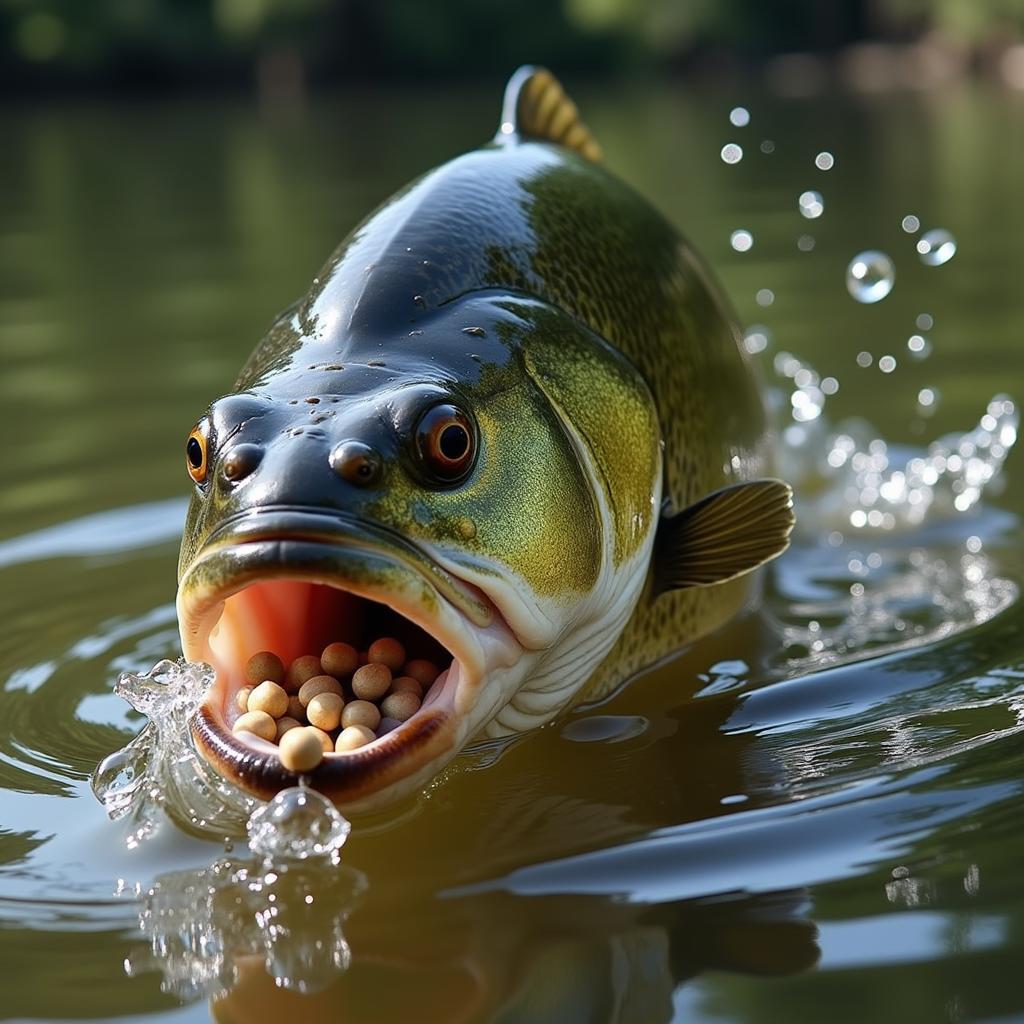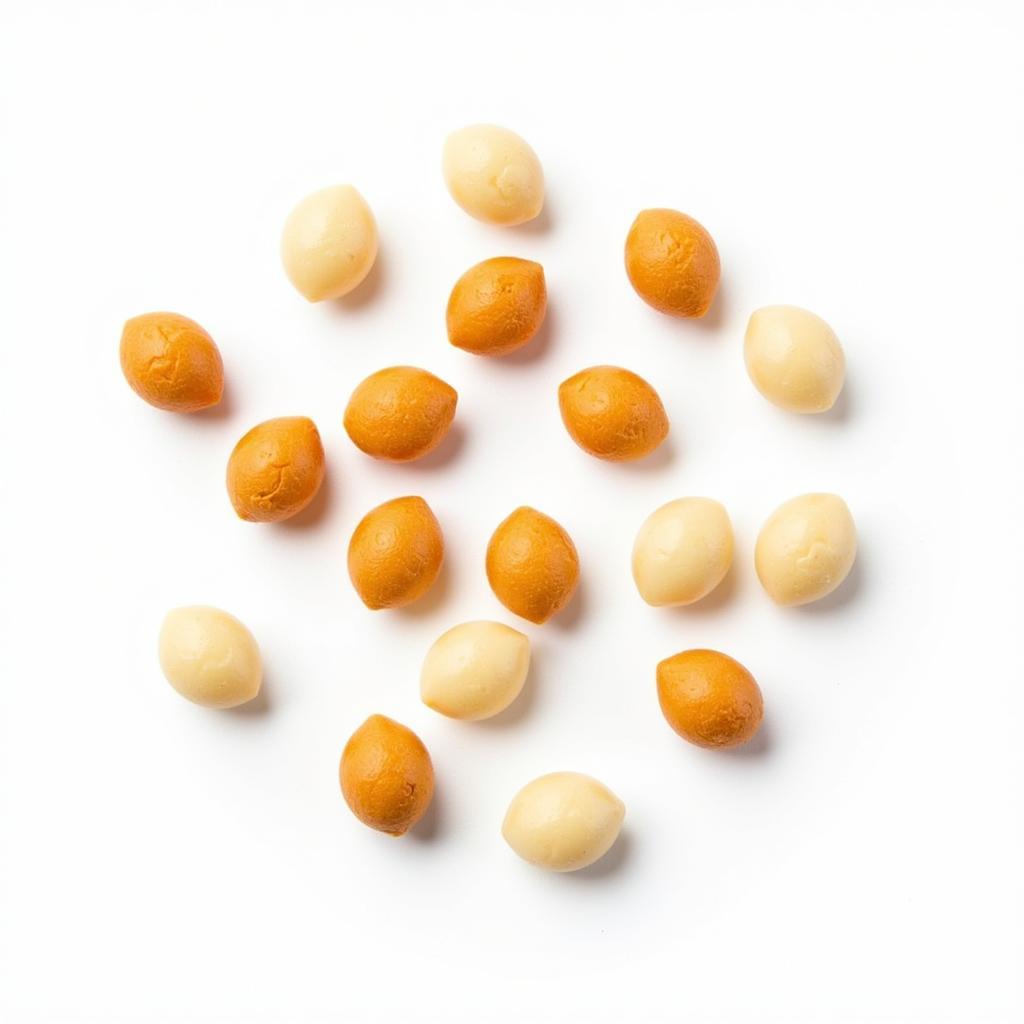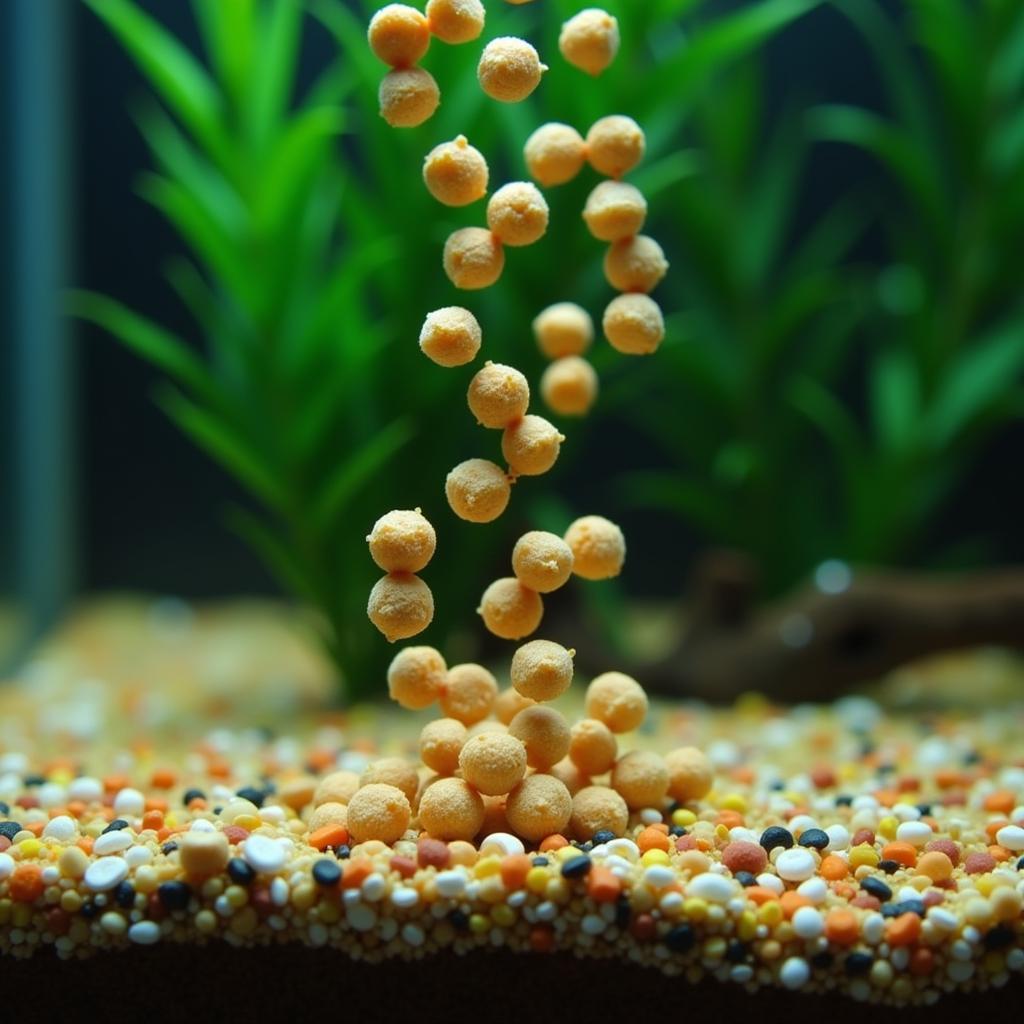Bass fishing is a beloved pastime for many, but ensuring these freshwater predators thrive in your pond or lake requires providing them with the proper nutrition. Understanding the best Fish Food For Bass is crucial for their growth, health, and ultimately, your fishing success.
 Bass Feeding on Pellets
Bass Feeding on Pellets
What Makes the Best Fish Food for Bass?
Bass are carnivorous fish, meaning their diet consists mainly of meat. Choosing the right food means understanding their dietary needs. Here’s a breakdown of the essential components:
- Protein: As carnivores, bass require high protein levels in their diet for energy, growth, and muscle development. Look for fish food with at least 40% protein content, primarily from fish meal, shrimp meal, or insect meal.
- Fat: Fat provides a concentrated energy source for bass, which is particularly important for their active lifestyle. Aim for fish food with a fat content between 10-15%.
- Fiber: While not a significant energy source, fiber aids in digestion and helps prevent bloating. Look for easily digestible fiber sources like wheat germ or kelp meal.
- Vitamins and Minerals: Just like humans, bass need a variety of vitamins and minerals for optimal health. Choose fish food fortified with essential nutrients like Vitamin C, Vitamin E, and calcium.
Types of Bass Fish Food
Knowing the different types of fish food available helps you cater to the specific needs of your bass:
1. Floating Pellets
 Floating Fish Food Pellets
Floating Fish Food Pellets
Floating pellets are a popular choice for bass as they mimic the behavior of their natural prey. These pellets remain on the water’s surface, allowing you to observe your bass feeding and adjust the amount accordingly.
2. Sinking Pellets
 Sinking Fish Food Pellets
Sinking Fish Food Pellets
Sinking pellets are ideal for bottom-feeding bass or those in deeper water. These pellets sink rapidly and maintain their shape, ensuring your bass gets a complete meal.
3. Live Fish Bait
Nothing entices a hungry bass like live bait. Minnows, shiners, and crawfish are all excellent choices. However, be mindful of introducing potential diseases or parasites to your pond or lake when using live bait.
Factors to Consider When Choosing Fish Food for Bass
Selecting the right fish food for bass goes beyond just the type. Here are some crucial factors to keep in mind:
- Age and Size of Bass: Young, growing bass require a higher protein diet than mature bass. Choose food specifically formulated for different life stages.
- Water Temperature: Bass metabolism slows down in colder water. Adjust the feeding frequency and opt for easier-to-digest food during colder months.
- Pond or Lake Conditions: Factors like water quality, fish density, and existing natural food sources impact the type and amount of supplemental feeding required.
- Budget: Fish food comes in a range of prices. Determine a budget that balances quality nutrition with affordability.
Feeding Tips for Healthy Bass
- Establish a Feeding Schedule: Feed your bass at the same time each day to establish a routine. This consistency helps them anticipate feeding time and promotes healthy growth.
- Don’t Overfeed: Overfeeding leads to uneaten food, which decomposes and negatively impacts water quality. A good rule of thumb is to feed only what your bass can consume within 5 minutes.
- Observe Your Fish: Pay attention to your bass’s feeding habits. Are they eagerly consuming the food? Are they leaving any behind? Adjust the type, amount, or frequency of feeding based on your observations.
- Store Fish Food Properly: Store fish food in a cool, dry place to maintain its freshness and nutritional value.
Conclusion
Selecting the right fish food for bass is essential for their well-being and ensures a thriving ecosystem for your fishing enjoyment. By understanding their dietary needs, the types of fish food available, and considering important factors like age and water temperature, you can make informed decisions to keep your bass healthy and your fishing lines tight.
Remember, providing your bass with optimal nutrition is an investment in their health and your angling success. Now that you’re equipped with this knowledge, go ahead and make the best choices for your finned companions.
FAQs
1. How often should I feed my bass?
Feeding frequency depends on factors like water temperature and the age of your bass. In warmer months, feed adult bass once a day, while younger bass may require two feedings. Reduce feeding to once every other day or less during colder months.
2. Can I give my bass human food?
While it might be tempting to toss your bass scraps from the dinner table, it’s best to avoid feeding them human food. Human food often lacks the necessary nutrients and can be difficult for bass to digest, leading to health problems.
3. How can I tell if my bass are getting enough food?
Observe your bass’s body condition. Healthy bass should have a rounded belly and display energetic swimming behavior. If you notice any signs of weight loss, lethargy, or unusual swimming patterns, adjust their feeding accordingly.
4. Where can I buy high-quality fish food for bass?
You can find reputable brands of fish food bass at local pet stores, fishing supply shops, or online retailers specializing in aquatic life.
5. What should I do if I see my bass ignoring the food?
If your bass aren’t interested in their food, it could be a sign of several things, such as improper water temperature, stress, or illness. Check your water parameters, ensure the food is fresh, and consider consulting with a fish health expert if the issue persists.
Need Help Choosing the Right Fish Food?
Choosing the optimal fish food for bass and bluegill can be a daunting task. For personalized advice and to explore a range of high-quality fish food options, contact our experts at Mina Cones Food. We’re here to help you make the best choices for your aquatic companions.
Contact us today at Phone Number: 02437655121, Email: [email protected] Or visit us at: 3PGH+8R9, ĐT70A, thôn Trung, Bắc Từ Liêm, Hà Nội, Việt Nam. We have a 24/7 customer support team.